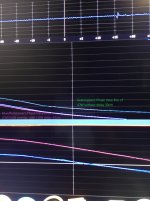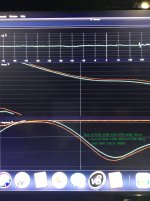Six months ago, I bought a second-hand DUNTECH Sovereign 2001 to fulfill a dream from my youth. However, its sound disappointed me, so I decided to modify it. After two months of research, the first step I took was to replace the original DA 30W100 06 subwoofers with Scan 30W/T4558T00, the DA 17W75 06 woofers with Scan 15W/8531K00, and the Scan D2010 tweeters with Scan D2104/71200. Since I couldn’t find an ideal replacement for the midrange drivers, I left them unchanged for now.
The second step was to remove the original passive crossover and install a custom 4-way speaker input panel, moving toward a fully digital 4-way active crossover setup. I'm using the ZIDOO UHD8000 streamer, which allows digital volume control on the SPDIF output, feeding directly into the Accuphase DF-45, then into power amplifier and speakers; no need for preamplifier. This ensures a clean and transparent signal path. The next step is to fine-tune everything using SMAART V8.( I had used SMAART since V3; the Floppy Disc era)
PS: The SCAN drivers for SUB and LOW cannot be directly mounted to the screw holes of the original DA drivers on baffle of Sovereign 2001. Custom-designed and 3D-printed adapter rings are required to fit them onto the existing DA mounting holes on baffle of Sovereign 2001.
The second step was to remove the original passive crossover and install a custom 4-way speaker input panel, moving toward a fully digital 4-way active crossover setup. I'm using the ZIDOO UHD8000 streamer, which allows digital volume control on the SPDIF output, feeding directly into the Accuphase DF-45, then into power amplifier and speakers; no need for preamplifier. This ensures a clean and transparent signal path. The next step is to fine-tune everything using SMAART V8.( I had used SMAART since V3; the Floppy Disc era)
PS: The SCAN drivers for SUB and LOW cannot be directly mounted to the screw holes of the original DA drivers on baffle of Sovereign 2001. Custom-designed and 3D-printed adapter rings are required to fit them onto the existing DA mounting holes on baffle of Sovereign 2001.
Attachments
-
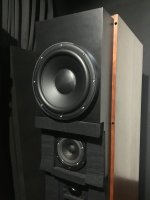 IMG_1345.jpeg392.8 KB · Views: 104
IMG_1345.jpeg392.8 KB · Views: 104 -
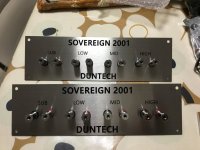 IMG_1453.jpeg370.6 KB · Views: 98
IMG_1453.jpeg370.6 KB · Views: 98 -
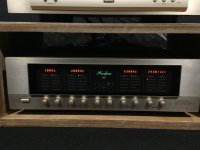 IMG_1459.jpeg382 KB · Views: 99
IMG_1459.jpeg382 KB · Views: 99 -
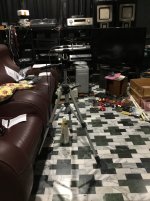 IMG_1496.jpeg778.8 KB · Views: 73
IMG_1496.jpeg778.8 KB · Views: 73 -
 IMG_1501.jpeg528.6 KB · Views: 75
IMG_1501.jpeg528.6 KB · Views: 75 -
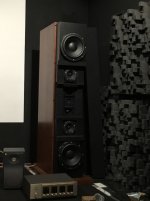 IMG_1500.jpeg495.9 KB · Views: 79
IMG_1500.jpeg495.9 KB · Views: 79 -
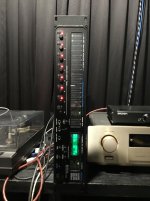 IMG_1497.jpeg745 KB · Views: 76
IMG_1497.jpeg745 KB · Views: 76 -
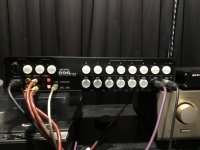 IMG_1498.jpeg671.4 KB · Views: 80
IMG_1498.jpeg671.4 KB · Views: 80 -
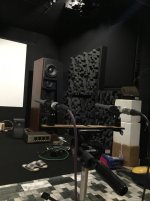 IMG_1506.jpeg599.3 KB · Views: 72
IMG_1506.jpeg599.3 KB · Views: 72 -
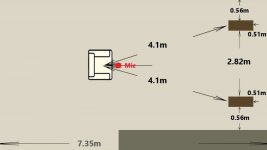 mic.jpg24.8 KB · Views: 65
mic.jpg24.8 KB · Views: 65 -
 11.jpg146.9 KB · Views: 12
11.jpg146.9 KB · Views: 12 -
 12.jpg151.3 KB · Views: 11
12.jpg151.3 KB · Views: 11 -
 13.jpg170.9 KB · Views: 16
13.jpg170.9 KB · Views: 16
Last edited:
Using SMAART V8 for time alignment of each speaker driver, it was found that: if the subwoofer is set as the zero point, the tweeter needs to be delayed by 18 cm, and both the midrange and woofer need to be delayed by 15 cm.
Using SMAART V8 again for time alignment of each set of 2 speaker drivers, it was found that: if the subwoofer is set as the zero point, the tweeter needs to be delayed by 36 cm, and the midrange by 33cm, and woofer by 30 cm. The Time Alignment as claimed by Duntech is not a true Time Alignment?
The timing measurement seems to be based on group delay. It is a virtual indication.
What does "true" time alignment mean to you? Of course I know you mean the real physical distance, but what acoustic benefits does lining them up this way achieve for you? It may be possible you can have them another way which we could look in to.
What does "true" time alignment mean to you? Of course I know you mean the real physical distance, but what acoustic benefits does lining them up this way achieve for you? It may be possible you can have them another way which we could look in to.
Thank you for your comment!
Sorry for not explaining clearly at the beginning — my Sovereign 2001's passive crossover has already been removed and replaced with an active crossover, the DF-45.
All the speaker drivers are now directly connected to the power amplifiers, so the delay time for the HIGH, MID, LOW, and SUB drivers can be adjusted through the DF-45 (in 1 cm increments).
I used SMAART V8’s delay locator (finder) function, rather than measuring the physical distance, because physical measurements are not accurate enough.
For the tweeter, midrange, and woofer, SMAART’s delay locator can very accurately measure the distance between each driver and the measurement microphone. However, for the subwoofer, it doesn’t work well — for subs, I had to use the phase trace instead.
In the case of my Sovereign, delaying the woofer by 30 cm allowed the phase traces of the woofer and subwoofer to align precisely at the crossover point (100 Hz).
With no phase difference, the gain around 100 Hz increased.
I’m at the office right now, but tonight when I get home, I will post screenshots from SMAART.
Sorry for not explaining clearly at the beginning — my Sovereign 2001's passive crossover has already been removed and replaced with an active crossover, the DF-45.
All the speaker drivers are now directly connected to the power amplifiers, so the delay time for the HIGH, MID, LOW, and SUB drivers can be adjusted through the DF-45 (in 1 cm increments).
I used SMAART V8’s delay locator (finder) function, rather than measuring the physical distance, because physical measurements are not accurate enough.
For the tweeter, midrange, and woofer, SMAART’s delay locator can very accurately measure the distance between each driver and the measurement microphone. However, for the subwoofer, it doesn’t work well — for subs, I had to use the phase trace instead.
In the case of my Sovereign, delaying the woofer by 30 cm allowed the phase traces of the woofer and subwoofer to align precisely at the crossover point (100 Hz).
With no phase difference, the gain around 100 Hz increased.
I’m at the office right now, but tonight when I get home, I will post screenshots from SMAART.
Assuming you replicate the original crossover, which I believe used exclusively first order filters, there's no need for additional delays. However if you've gone mucking about to make new order filters then you have to re-assess the time alignment per driver based on phase alignment, and you now have an entirely different loudspeaker on your hands.
He is using a Accuphase DF-45. For DSP/filtering.
It comes with 'preadjustable' , crossover frequencies, slopes etc. So to emulate the original crossover might need more adjustability then that. Not sure if the 96db/oct slopes is all it can do. Would have to research the 'subject'.
It comes with 'preadjustable' , crossover frequencies, slopes etc. So to emulate the original crossover might need more adjustability then that. Not sure if the 96db/oct slopes is all it can do. Would have to research the 'subject'.
Sorry for not explaining clearly at the beginning — my Sovereign 2001's passive crossover has already been removed and replaced with an active crossover, the DF-45.
All the speaker drivers are now directly connected to the power amplifiers, so the delay time for the HIGH, MID, LOW, and SUB drivers can be adjusted through the DF-45 (in 1 cm increments).
I used SMAART V8’s delay locator (finder) function, rather than measuring the physical distance, because physical measurements are not accurate enough.
For the tweeter, midrange, and woofer, SMAART’s delay locator can very accurately measure the distance between each driver and the measurement microphone. However, for the subwoofer, it doesn’t work well — for subs, I had to use the phase trace instead.
In the case of my Sovereign, delaying the woofer by 30 cm allowed the phase traces of the woofer and subwoofer to align precisely at the crossover point (100 Hz).
Nice speakers, nice crossover !
What order crossovers are you using?
I'd suggest you ignore the woofer section for a while, and focus on making sense of the time alignments between the other three sections until you think they make full sense to you.
As you've found, Smaart's delay locator is repeatedly accurate for high, mid, and low...but not so so for sub. This is true for ALL measurement programs (including REW for example), due to the nature of FFT being linear data collection across frequency. To compound that FFT issue, indoor sub reflections are often nearly the strength of the direct sub. And to compound the sub measurement difficulty even further, it's the rise of the sub's impulse that needs to be time aligned, not the peak. Try to determine that vs peak impulse with any precision.
Anyway, hope this leads to ignoring the sub until you have a good handle on why the Sovereign is showing timing discrepancies. Then work on sub.
Are you using the DF-45's filter time correction? If so, do you have a way to sum the DF-45's electrical outputs into a mixer and run a transfer function on the summed output? This would be using crossovers at the same frequency simply to see the time alignment of the units outputs. Frankly, I think Accuphase has it wrong doing filter time correction, and maybe this is the possible source of the timing you're seeing. (But who am I vs Accuphase engineering.) I'd love to hear the results of said test if you can do it.
If you can't do it, try using Smaart delay locator against differnt order filter sets. Run the whole speaker using first order, then higher order to see if relative time changes. It shouldn't. If it does, i think it's an indication I'm correct and Accuphase is screwing up with their filter delay compensation.
Good luck !
I should point out also that with a speaker like this (large vertical distance between outer most drivers and tweeter) , your delay times are only going to be correct when measured like 10' away or longer, which makes it very hard to measure accurately due to room interactions. This is in addition to all the other crossover problems you are facing.
Compare to a small 2-way... where the delay times are probably accurate by 3' distance.
Compare to a small 2-way... where the delay times are probably accurate by 3' distance.
I set the crossover point of DF-45 to 100-2000-6300Hz, slope =-24db/oct, interface= MOTO 896 hybrid,testing Mic=Behringer M8000, Mic was placed 5 meters in front of the center line between the L/R speakers(in front of my listening seat), about 40 degrees off-axis to center axis of L/R speakers . I realize that the auto delay compensate function is not reliable, so I OFF this function. Below photos are zoom in screen shot of SMAART V8.
Attachments
Last edited:
I try to set slope to -6db/oct (original crossover) and find that LOW need to delay 110cm to make SUB/LOW phase trace overlap instead of 30cm when slope is -24db/octAssuming you replicate the original crossover, which I believe used exclusively first order filters, there's no need for additional delays. However if you've gone mucking about to make new order filters then you have to re-assess the time alignment per driver based on phase alignment, and you now have an entirely different loudspeaker on your hands.
I try to set slope to -6db/oct (original crossover) and find that LOW need to delay 110cm to make SUB/LOW phase trace overlap instead of 30cm when slope is -24db/oct
Well that's kind of what I'm getting at. Now you are throwing away the time/phase perfect performance of the originals. Also, that is huge. I suspect you are measuring too closely to the speaker. Check proper alignment by inverting the polarity of one of your drivers and looking for a severe dip.
Last edited:
Is that the filter slope or the overall slope?I try to set slope to -6db/oct (original crossover)
Does it match the other half of the crossover?
You want it to overlap for first order?to make SUB/LOW phase trace overlap
John Dunlavy said the most important attribute of a speaker was near-perfect step response and linear phase. The original design went to extraordinary lengths to achieve this. As far as I can tell this new implementation sets all of that aside. Am I understanding the new digital crossover correctly?Well that's kind of what I'm getting at. Now you are throwing away the time/phase perfect performance of the originals. Also, that is huge. I suspect you are measuring too closely to the speaker. Check proper alignment by inverting the polarity of one of your drivers and looking for a severe dip.
@jblpro5234 Per my comment just above... also referencing this excellent interview: https://www.stereophile.com/interviews/163/index.html .....
I would like to encourage you to carefully study John Dunlavy's designs and philosophy and dig into the deep thinking behind his work. The Duntech Sovereign is a masterpiece of engineering, one of the best speakers ever made; so if I were making an active version, I would adhere as closely to his original philosophy as possible.
He achieved linear phase, near-perfect step response and near-perfect square waves (almost unheard of in any speaker design, only a very few old school manufacturers ever managed to achieve this) using a combination of passive components and driver modifications (ie damping rings etc to mitigate breakup modes).
I'm pretty sure that his designs also achieve something like a D'appolito vertical polar pattern. Basically the guy figured out how to kill 4-5 birds with one stone, using "bow and arrow" technology, no "nuclear weapons".
I think you're in danger of using nuclear weapons and super steep crossover slopes in a way that violates his original design objectives, and I really think his objectives were highly worthy and still 100% relevant today. The best digital designers are those who mastered analog first.
If I were transforming the Sovereign into an active design, I would use the DSP to aim for 6dB/octave very well-behaved acoustic slopes just as Dunlavy did. And I would conservatively apply FIR filters to solve whatever problems that remain.
The nice thing about DSP is that you can do as many configurations as you want and save them to a file and compare them.
So it's not like there's a big conflict here. You can do whatever you were planning to do, and try this approach as well, and compare.
Personally I resist super steep crossover slopes, and if I have to use them, I use FIR filters to unwind the phase shift, because a 4-way system with steep crossover slopes is going to butcher impulse and step responses. I do not believe that sort of approach will sound better than the original.
I used a lot of Dunlavy's ideas in my Bitches Brew design. One of the things I learned by imitating Dunlavy's minimum phase approach is that when you push the universe in "here" it pops out "over there" and there's never a free lunch. You have to apply your filtering resources very skillfully in order to pull that off.
FIR DSP gives you latitude to "cheat" by separating time domain from frequency domain, so it's "nuclear weapons" but that doesn't alleviate the need to design conservatively. There are good reasons why some people prefer the sound of shallow slope crossovers.
I think it is very much possible to produce a design that's better than the original Duntech using active DSP and it would be amazing to hear the results of that.
I would like to encourage you to carefully study John Dunlavy's designs and philosophy and dig into the deep thinking behind his work. The Duntech Sovereign is a masterpiece of engineering, one of the best speakers ever made; so if I were making an active version, I would adhere as closely to his original philosophy as possible.
He achieved linear phase, near-perfect step response and near-perfect square waves (almost unheard of in any speaker design, only a very few old school manufacturers ever managed to achieve this) using a combination of passive components and driver modifications (ie damping rings etc to mitigate breakup modes).
I'm pretty sure that his designs also achieve something like a D'appolito vertical polar pattern. Basically the guy figured out how to kill 4-5 birds with one stone, using "bow and arrow" technology, no "nuclear weapons".
I think you're in danger of using nuclear weapons and super steep crossover slopes in a way that violates his original design objectives, and I really think his objectives were highly worthy and still 100% relevant today. The best digital designers are those who mastered analog first.
If I were transforming the Sovereign into an active design, I would use the DSP to aim for 6dB/octave very well-behaved acoustic slopes just as Dunlavy did. And I would conservatively apply FIR filters to solve whatever problems that remain.
The nice thing about DSP is that you can do as many configurations as you want and save them to a file and compare them.
So it's not like there's a big conflict here. You can do whatever you were planning to do, and try this approach as well, and compare.
Personally I resist super steep crossover slopes, and if I have to use them, I use FIR filters to unwind the phase shift, because a 4-way system with steep crossover slopes is going to butcher impulse and step responses. I do not believe that sort of approach will sound better than the original.
I used a lot of Dunlavy's ideas in my Bitches Brew design. One of the things I learned by imitating Dunlavy's minimum phase approach is that when you push the universe in "here" it pops out "over there" and there's never a free lunch. You have to apply your filtering resources very skillfully in order to pull that off.
FIR DSP gives you latitude to "cheat" by separating time domain from frequency domain, so it's "nuclear weapons" but that doesn't alleviate the need to design conservatively. There are good reasons why some people prefer the sound of shallow slope crossovers.
I think it is very much possible to produce a design that's better than the original Duntech using active DSP and it would be amazing to hear the results of that.
OP: I don't know if these were the best speakers ever, but I do think that converting to active without fully understanding the original design is depressing.
I'm a big fan of active designs, and if you had understood the original and converted that crossover as an active this would make a lot of sense to me.
Alone the drivers are not very interesting or expensive, it's the final result in the frequency, time and phase alignment which made these speakers legendary.
If you want to deconstruct these speakers and reimagine them with entirely new crossover slopes I strongly encourage you to learn how to do phase / time alignment for a single 2-way speaker. Grab VituixCAD and some sample data from Dayton Audio. They are good enough to publish FR charts for all their drivers. Once you understand how to do that you'll have a much better grasp at evaluating your crossover choices with what you have.
I'm a big fan of active designs, and if you had understood the original and converted that crossover as an active this would make a lot of sense to me.
Alone the drivers are not very interesting or expensive, it's the final result in the frequency, time and phase alignment which made these speakers legendary.
If you want to deconstruct these speakers and reimagine them with entirely new crossover slopes I strongly encourage you to learn how to do phase / time alignment for a single 2-way speaker. Grab VituixCAD and some sample data from Dayton Audio. They are good enough to publish FR charts for all their drivers. Once you understand how to do that you'll have a much better grasp at evaluating your crossover choices with what you have.
Here's the only thread I could find with the original crossovers of a similar speaker. Note they consistently use single order filters with significant frequency shaping. If you attempted to rethink these speakers with new order filters you have to rethink the time/phase alignment and recreate the equalization in the original, or re-imagine the EQ. Not speakers that would do well without EQ
I am working on rebuilding the crossovers in my Duntech Crown Prince speakers. After speaking with Duntech AU they suggested replacing all the capacitors and resistors as Technology in the last 20 years has greatly improved these parts. So I have torn one crossover apart and mapped out the schematic and verified all the parts values with the exception of the Inductors which i will have measured next week.
There are many interesting things and some puzzling things as well about this crossover design. I will start with the top working down on the schematic.
There are many interesting things and some puzzling things as well about this crossover design. I will start with the top working down on the schematic.
This is amusing. The OP is using only the original box, and temporarily the mids, and everyone posting is trying to tell him he needs to follow the design goals of the original design, which he already said, he didn't care for.
It is no longer a DUNTECH Sovereign 2001. It's his design. He should make design choices the same as anyone else building a pair of speakers.
It is no longer a DUNTECH Sovereign 2001. It's his design. He should make design choices the same as anyone else building a pair of speakers.
I missed that all the drivers had been changed, but most of the advice I've given stands. He's probably not aligning the speakers correctly, and learning to do that should be high on his priority list.
- Home
- Loudspeakers
- Multi-Way
- Fully digital active 4-ways Xover AQ DF75 DUNTECH Sovereign 2001
